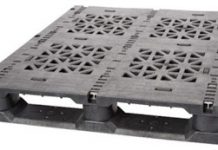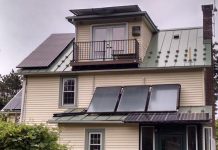This article is part of a series on the WGA Energy Efficient Buildings Workshop.
Sam Rashkin 
One highlight of the conference was Sam Raskin’s (the National Director a.k.a. "Scary Man" of the US EPA Energy Star program.) I recommend his presentation for graphic infrared images of poorly sealed homes, showing how little the insulation is doing to retain heat or cold if the building envelope is not tight. It will make you think twice about buying a home that hasn’t been checked to be tightly sealed.
Rashkin believes that the growing affordability of infrared cameras will allow home inspectors to use them so that builders will no longer be able to hide shoddy insulation and sealing of building envelopes, giving a strong competitive advantage (over both "used homes" and other builders) to builders who can get these things right.
Along the way, he commented that wide-scale adoption of Plug-in Hybrids (PHEVs) may lead to $.40/kWh electricity. While I wish he were correct about this, because of the investments in energy efficiency that such a scenario would catalyze, I doubt that PHEVs alone would lead to such an escalation of electricity prices. In fact, some studies show that PHEVs may lower per kWh cost of electricity by allowing us to use our grid more efficiently, and spreading fixed costs of generation to more electricity sold.
While current energy Star standards focus on right-sizing HVAC equipment and the building envelope, he expects future versions to include
- Better solar orientation (long, south-facing walls keep a building cool in the summer and warm it in the winter, with proper overhangs and window sizing.)
- A move to avoid solid areas of wood support members, where there isn’t room for insulation.
- Making sure that air ducts remain in the conditioned parts of the house.
- Structured plumbing, which can improve the efficiency of water heating by 25% by reducing the amount of water that cools off in pipes when not in use.
- Advanced lighting… his presentation also contained a series of pictures effectively debunking the myth that fluorescent lighting has to be harsh.
- He also expects a move to the "not so big house." I’m more cynical about that, but it could happen when much higher energy prices really begin to start hitting consumers in the wallet.
Eric Borsting, of the National Association of Home Builders (NAHB)
Mr. Borsting began his presentation by emphasizing that he was there representing NAHB, and I don’t blame him from trying to dissociate himself as much as possible from the canned, finger-pointing speech he read to us in a dull monotone. The NAHB’s position (in my words) is that lack of energy efficiency in new homes is not their fault, we should look instead to energy-inefficient occupants, and do something about old homes first. They completely avoid the fact that every inefficient old home was once a badly constructed new home. They’re terrified of mandates for energy efficiency, arguing instead that they should be given incentives to build homes responsibly.
The NAHB says that every $1000 added on to the price of a new home, "prices out" 240,000 households from the market. What this study completely ignores is that energy efficiency improvements are extremely cost effective, and actually lower the cost of ownership of the home (when including both mortgage costs and utility bills.) Recognizing this, the Energy Efficient Mortgage program allows buyers of energy efficient homes to increase the size of the mortgage they qualify for or to lower the interest rate they are charged. Thus, energy efficiency improvements can actually price in hundreds of households into the home ownership market, in direct contradiction with the NAHB’s party line. Like many entrenched interest groups, they are so afraid of changing the way they do things that they work against their own self interest as home builders by resisting energy efficient building techniques.
Kim Calomino
Kim Calomino, director of the Built Green Colorado program of Home Builder’s Association of Metro Denver, stuck a little less tightly to the Home Builder Association’s line, arguing that much could be accomplished by voluntary "above code" programs. While she was persuasive that voluntary programs such as Built Green can do a lot to improve energy efficiency, this argument also presents a false dichotomy between more stringent energy codes and voluntary programs. There is indeed an effective place for voluntary codes, but that does not mean that they cannot be in addition to mandatory rules that all buildings must include economic efficiency measures.
She did provide a rare example (including actual costs and savings) of the benefits of Built Green improvements, from McStain Neighborhoods. She listed the itemized costs associated with meeting the Built Green standard (not all of which are energy efficiency improvements), with a total of $555 in annual utility savings for a $4600 premium on a Built Green home. Her presentation is available here (see slide 9).
I calculate the internal rate of return (IRR) on McStain’s investment in a Green Built Home to be a 10%. That means that the additional cost of this home can be profitably financed at any interest rate below 10%. My IRR calculation assumes that the improvements continue to produce savings for 20 years, but also that energy prices do not rise over that same period, so the likely errors in the calculation will be in opposite directions (giving a lower IRR for shorter-lived improvements, but a higher IRR if energy prices rise.)
Taking into account the fact (repeatedly stressed by Ms. Calomino) that there are many other benefits to Built Green homes in terms of comfort, air quality, and durability, it seems insane to me that inexpensive improvements such as those required by Built Green should not be required by code so long as the internal rate of return on the investment in energy efficiency is greater than the interest rate on the mortgage used to finance it, because the air quality, comfort, and durability benefits she points to would still be, essentially free.
Gil Rossmiller
Link to Mr Rossmiller’s presentation.
Gil Rossmiller, the Chief Building Official of southeast Denver exurb Parker, CO gave us all a reality check, by bringing home the fact that if 12% of new homes meet Energy Star standards, then 88% don’t meet these not-too stringent standards. For that 88%, Energy Star standards are irrelevant, and a focus on proper enforcement of the existing building code for the vast majority of homes will do a lot more for energy efficiency than adding a couple of percent to the number of homes that qualify. The sad fact is, that even the weak energy codes we do have are only as good as their enforcement… and he showed how he was able to greatly improve builder’s standards simply by rigorously enforcing just the existing, much derided code.
Stories like this tempt me to despair because they show just how bad things are, but they can also lend hope. We don’t have to pass a raft of new laws to make progress tackling our energy problems; a lot of progress can be made by just enforcing the code that we already have.
Investment ideas
All speakers constantly emphasized that bringing up energy efficiency requires extensive education and outreach, not just higher standards. Because of that, we can expect that there will be an increase in government contracts for that purpose. Advertising and education are not a sectors I’m familiar with, but if you know of a public company you feel can profit from this trend, I suggest you think seriously about investing. On a more whimsical note, you might take Sam Rashkin’s thoughts to heart, and invest in makers of infrared cameras.
Among homebuilders, Lennar Corporation (NYSE:LEN) was mentioned at least twice as a pioneer in energy efficient building practices.
When it comes to energy efficient homes, the two big issues will be insulation and sealing. I had the opportunity to speak with two industry insiders about this, and they felt that proper sealing depends much more on proper installation than the particular product used. This agrees closely with what most of the speakers were saying during the presentations. Unfortunately, this means that it will be difficult for any particular product to gain market share unless it is easier to install than rival products. There isn’t currently any product on the market with a real competitive edge in this regard, but a homebuilder with a rigorous training program for installers might be able to capture value, if they were also able to retain staff.
The big public players in the insulation industry are Owens Corning (NYSE: OC), which one of my informants (a research engineer at a rival firm) says has a quality research department, and Johns Manville (JM), which is owned by Berkshire Hathaway (NYSE:BRKa). However,JM is too small a part of Berkshire to warrant investment in Berkshire for an investor looking for exposure to the insulation industry. The final major insulation manufacturer is CertainTeed, but they are a private German firm. Dow Chemical (NYSE: DOW) also has exposure to the air sealing space, as does DuPont (NYSE:DD) with their household name Tyvek weather resistant barrier.
Unfortunately for investors, I felt that the take away message was that no insulation manufacturer has a strong technical edge, although Owens Corning may be the default investment in this space simply because they provide the purest exposure to the insulation industry.
The largest potential market for insulation in this industry is blow-in insulation in attics, because it is something that is easy to do in an existing home, and you get a lot of energy savings for a very small outlay. Blow-in fiberglass insulation (which often includes significant recycled glass content) has the best thermal performance, followed by cellulose (usually made from recycled newspaper). All the major manufacturers have blow-in fiberglass product.
Extremely high R-values can not be achieved with current practices (filling the gaps between studs with insulation). If forced to much higher standards, builders will most likely move to rigid foam external sheathing, versions of which are made by Johns-Manville, Owens Corning, and Dow Chemical. While these products may currently be practical for custom homes, production builders don’t like to use them, and these three companies might gain a competitive edge from a large increase in home energy standards. However, I feel such a scenario is improbable within the next five years.
Links:
WGA Energy Efficient Buildings Workshop series overview.
Political Developments for Energy Efficiency in Western States
You can find links to future installments by clicking here.
Energy Efficient Buildings workshop presentations.
DISCLOSURE: Tom Konrad and/or his clients have positions in these companies mentioned here: OC, DD.
DISCLAIMER: The information and trades provided here are for informational purposes only and are not a solicitation to buy or sell any of these securities. Investing involves substantial risk and you should evaluate your own risk levels before you make any investment. Past results are not an indication of future performance. Please take the time to read the full disclaimer here.








